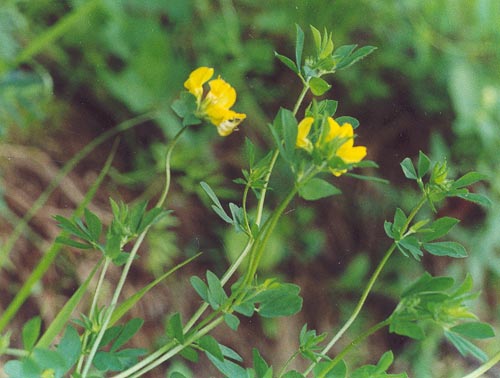Relatives
Lotus tenuis Waldst. & Kit. ex Willd. - Slender Bird.s-foot-trefoil.
Taxonomic position.
Family Fabaceae Lindl., genus Lotus L.Main synonyms.
L. corniculatus L. b. tenuis L.; L. tenuifolius Rchb.Morphology and biology.
Perennial plant. Stems numerous, ascending, slender, glabrous with glaucous bloom, 20-60 cm tall. Lowermost pair of leaflets (substituting stipules) lanceolate; three pairs of upper leaflets lanceolate or linear-lanceolate, acuminate, 7-15 mm long and 2-4 mm wide. Peduncles long, slender, with 2-4 flowers in inflorescence. Calyx glabrous, 4-5 mm long, with linear teeth, teeth as long as tube. Corolla yellow, turning blue when dry. Standard 7-9 mm long, 5-7 mm wide, on cuneate unguis. Wings and keel on short unguis. Pods cylindric, linear, 25-30 mm long, 2-3 mm wide. 2n=12.Flowers in June, fruits in July.
Distribution.
General distribution: Central and Atlantic Europe, Mediterranean, Caucasus, Central Asia (south). Former USSR: European part - Black Sea, Lower Don, Upper Dniester, Middle Dnieper, Lower Volga (Astrakhan environs) regions; Crimea; Caucasus - Ciscaucasia; Central Asia - mountain Turkmenistan (Kushka environs).Ecology.
Wet salty meadows and sands, forest glades and felled areas, wet sandy seashores.Use and economic value.
Used as green forage, softer and richer in carbohydrates than clover and medick. Less yielding than L. corniculatus L., but thrives better on saline soils.References:
Grossheim AA. 1952. Flora of Caucasus. 2nd ed. V.5. P.390. (In Russian).Minjaev NA., Ulle ZG. 1987. Bird.s-foot-trefoil - Lotus L. In: Fedorov AA., Tzvelev NN., eds. Flora of the European part of the USSR. V.6. P.114. (In Russian).
Shishkin BK., ed. 1945. Flora URSS. V.11. P.292-295. (In Russian).


